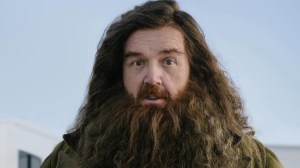
Superman: Year One #1, the first over-sized issue in this three-part origin story, takes Clark Kent from the destruction of Krypton to leaving Smallville behind for his first adult adventures. After the first few pages, the focus rests entirely on small town Kansas, a largely idyllic place where Jonathan and Martha Kent can raise their son to use his powers wisely. This version of Smallville, as crafted by writer Frank Miller and artist John Romita Jr., is reminiscent of Riverdale. That’s not the Riverdale currently popularized on television, one filled with melodrama and adult twists, but the small town Americana initially distilled in the 1940s. It’s a place where children hang out in cliques with each individual distinguished by a single trait, and one where the whole town can come together for the right reasons (with a single notable exception). It’s the sort of place that has never really existed and carries with it many of the prejudices and problems that went ignored by Archie 70 years ago and, now, Superman: Year One today.
Videos by ComicBook.com
A single narrator describes the collage of events that compose Clark Kent’s life before he leaves Smallville. At times this narrator reads as being Clark speaking directly to the reader about how he feels in a given moment, but it often reverts to Miller’s voice describing Clark’s actions and emotions. It is a truly bizarre form of presentation lacking any clear voice, one that reads like notes from an outline transcribed, without editing, onto a final draft. This narrative chimera describes childhood in the Great Plains, serving up a complex and diverse region of the United States in stereotypes. Every child appears to have two parents and a clear set of friends. Teachers refer to their students as darlings and the surfaces of the town appear like Main Street U.S.A. in Disneyworld. It’s the version of Kansas that is often imagined or satirized, but one that has certainly never existed.
It might be possible to read this as Miller and Romita summoning the dream of what the United States could be, a potential first described in the Declaration of Independence that many readers often see in the figure of Superman. However, their version of Smallville is shown to be far from idyllic as it makes clear their are very real demons lurking beneath that smalltown surface. A pack of bullies roam the hallways and streets of Smallville, initially appearing somewhat benign. These young men don’t behave like any serious threats encountered in the high school hallways of the past or present, and they won’t even let their language go beyond (admittedly still inappropriate) terms like “peckerwoods” and “pansy,” with their most egregious act being an egging. These are jerks from a PG movie in the Reggie Mantle model.
And then Superman: Year One #1 takes a very dark turn. Clark states that teachers, parents, and administrators are terrified of these bulles, further implying that only the police (and violence) are capable of handling such men. This discrepancy between Clark’s opinion and the presentation of these bullies is finally removed when the same groups attempts to rape Lana Lang. The attempted rape sequence is only a few pages and deeply disquieting. Romita emphasizes Lana’s helplessness, showing close ups of her crying, screaming face as hands paw at it and her unseen body beneath the panel. It is gratuitous and presents a tonal mismatch the rest of the issue, one that is never amended.
This rape sequence is only a symptom of a much more insidious flaw in Superman: Year One, along with much of Miller’s prior work. It reduces women to objects, things to be praised, saved, or damned—a thread that is present across all of Superman: Year One. There are only two prominent women in this issue, Martha Kent and Lana Lang, both of whom are referred to as being “angels” at least once. Their visual representation and behavior reflect this view of how women operate in the world. Both are defined by their service to the men in their lives, as wives, girlfriends, and unwavering cheerleaders. Martha Kent only wavers in playing this part when she fears for her son being exposed to violence, and in doing so reinforces the masculine role of protector and leader present across this issue. Superman: Year One embraces the madonna-whore dichotomy by only allowing its heroic women to exist in the former category, depicted as heavenly creatures. You need look no further than the only pages in which Lana Lang is shown without Clark towering over her to realize this: in one she is terrified of sexual assault and in the other she is pledging to wait for Clark’s return. Lana never exists outside of Clark’s power and needs.
There are other problems with this issue, plenty of them. John Romita Jr. and Danny Miki remain a killer team, with Miki’s inks making Romita’s pencils look as good as they have in decades. However, there remains a massive gap between his depiction of adults and children, with the latter filling much of this issue and looking like odd, clay sculptures of human beings that tumble into the uncanny valley. The pacing and plotting of the comic (leaving issues of sexism and militant nationalism aside) is irregular, at best. Some sequences, like a victorious football game, appear to be setting up larger themes and character interactions, only to be ignored. Superman: Year One #1 is uneven and disjointed on a superficial level, and deeply troubling once one begins to examine its ideology.
Returning to the Riverdale of the 1940s and 50s, this is a vision of Superman that likely existed in the hearts and minds of many young men who grew up reading comics from that period. He is a powerful individual prepared to enforce his vision of what is right upon the world, noting the value of power and violence at the dinner table. He is served by the women and friends around him, a ready hero for their praise and unending support. Yet he is the only character that exists in this tableau, an individual who defines others solely in their relationships to himself. Thus he is a version of Superman isolated from humanity, one capable of dominating, but incapable of love. Why would we ever aspire to that form of heroism?
Published by Black Label, an imprint of DC Comics
On June 19, 2019
Written by Frank Miller
Art by John Romita Jr.
Inks by Danny Miki
Colors by Alex Sinclair
Cover by John Romita Jr.









